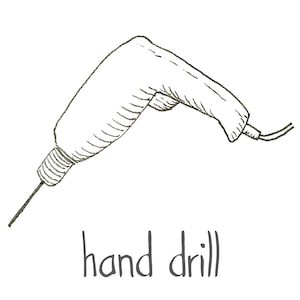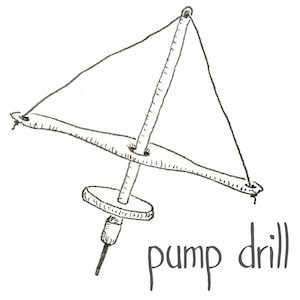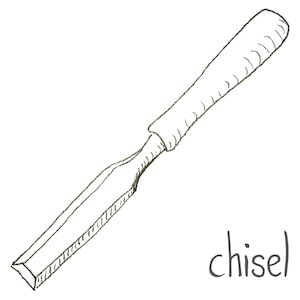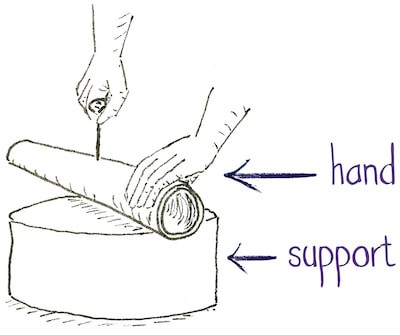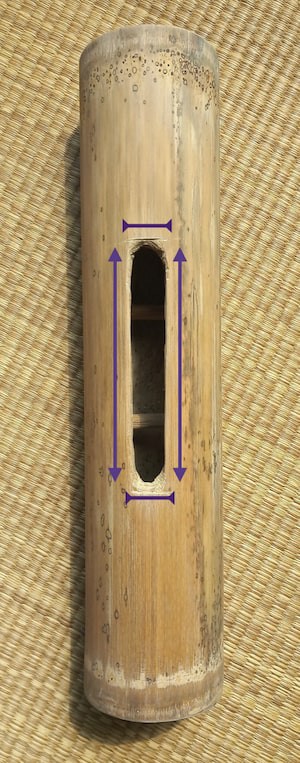How to drill bamboo for making crafts?
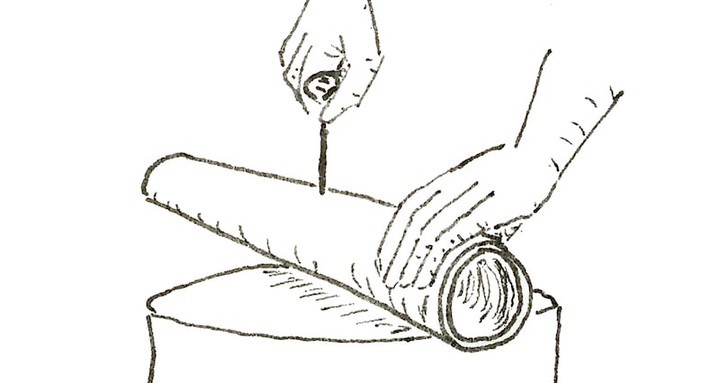
Which kind of tool can I use to drill bamboo? How to mark and immobilize the bamboo? How to use carving tools to drill a hole?
Here is a short tutorial based on a video review of 9 highly skilled bamboo craftsmen from around the world.
This tutorial is part of my bamboo craft project where I share tutorials, prototypes and resources for designing and building bamboo objects with simple tools.
Video review (4 min 30 sec)
Wear gloves for safety!
It is always a good idea to wear gloves if you are a beginner, at least one glove for the more vulnerable hand which is holding the bamboo.
Which tool can I use to drill bamboo?
Craftsmen use a lot of different tools to drill bamboo, depending on what they want to do.
Among basic bamboo craft techniques, drilling is the most demanding for the arm and the wrist. It is hence very common to use an electric hand drill.
When the work needs to be very precise, with a lot of small holes to make, craftsmen can use a drill press.
For some crafts, such as fishing rods, craftsmen can use very long drill rods to bore thin bamboo shafts lengthwise (see video).
But the most fun drills are probably the manual ones! If we don’t need to drill a lot of holes, gimlets can be very efficient and precise.
Sometimes, we need to drill larger holes, for instance for inserting one bamboo into another. There are two main approaches.
The second approach is to use carving tools, such as chisels. It is used when we don’t have access to a hole saw, or if we need to open a hole which is not round. It is very common, for instance when making specific kinds of joints where a bamboo pole is inserted into another one.
This technique can be a bit intimidating for beginners, but for experts, making a hole using carving tools can be as quick as using an electric tool!
How to mark and immobilize the bamboo?
Before drilling, you can locate where you want your hole to be. For instance, you can mark precisely the center of your hole by punching. Or, with a pencil, you can draw the shape of the hole you want to make.
To drill safely, and precisely, you need to immobilize the bamboo between one hand and a wood support.
Craftsmen often use the feet for a better grip, especially when carving because the two hands are busy with the chisel and the mallet!
And for long bamboo poles, it can be much easier to be two people so that one can hold the pieces while the other one is drilling.
How to use a carving tool to drill a hole?
For carving bamboo, you need a mallet and a wood carving tool, such as a chisel (straight cutting edge) and/or a gouge (curved cutting edge).
A gouge can allow you to make rounded holes, and craftsmen tend to use only a gouge, including to make straight cuts, as the bamboo fibers will anyway separate in a straight line when you hit the pole lengthwise with a blade (see video).
After drawing the shape of the hole and finding a stable position, craftsmen invariably carve their holes in this way: they start by notching the bamboo pole widthwise  , that is, perpendicular to the fibers.
, that is, perpendicular to the fibers.
When they have cut on two opposite edges, they notch lengthwise  with their carving tool, between the two previous notches. This latter shock will separate the bamboo fibers and the bamboo piece is bound to detach easily.
with their carving tool, between the two previous notches. This latter shock will separate the bamboo fibers and the bamboo piece is bound to detach easily.
Finally, you can open the hole even more if necessary, still using your carving tool, and smoothen the edges of the hole using the same carving tool, a small knife, and/or sandpaper.
Be careful when using carving tools, because they can slide. Ideally, you make sure that no part of your body is in the direction where you push the blade of your tool. Like this, even if you lose control of the chisel, you cannot injure yourself. This is a little bit more difficult to achieve if you use your feet, as so many parts of your body will surround the bamboo…
But unless you want to look like an expert, you don’t necessarily need to be barefoot!
Did you enjoy this post?
Great! Then, you may also like to read how to saw bamboo and how to split bamboo into flat slats.
References used in the video
- Japan - fushimiurushikobo, 2014, Making the rim of a small plate
- Unknown location - INBAROfficial, 2017, Making Amazing Furniture from Bamboo
- Japan - Woodworking Enthusiasts, 2018, Ancient Technology of Making Bamboo Crafts - Most Incredible Bamboo Woodworking Ever
- Japan - Woodworking Enthusiasts, 2018, Highly-Skilled Bamboo Craftspersons Specialized in Making The “Kishu Fishing Rods”(Kishu Herazao)
- Taiwan - shengfenchien, 2009, bamboo chair (1 to 6)
- Hong Kong - Milk Design, 2015, making a Bamboo Chair
- Georgia - TLC Channel, 2019, How to make bamboo chair beautiful | Bamboo Furniture making
- Indonesia - R B, 2016, How to make a bamboo serving tray
- Japan - fushimiurushikobo, 2008, Curry spoon,bamboo (from 1 to 6)
